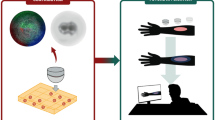Abstract
We present novel imaging results from a non-invasive examination of three ‘pattern-welded’ swords from the Viking Age belonging to the National Museum of Denmark, using white beam and energy resolved tomographies with neutrons. Pattern-welded blades are made by forge welding together thin strips of iron and steel that were twisted and joined in various ways, producing a decorative pattern on the surface. The study shed light on the inner structure of the composite material and manufacturing techniques of these admired examples of past technology, revealing some otherwise invisible details of their assembly methods, phase distribution and extent of the corrosion.













Similar content being viewed by others
Notes
N = ρN a /m, where ρ is the density (g cm−3), N a is Avogadro’s number (6.022 × 1023) and m is the atomic mass (g).
Cementite is an iron carbide (Fe3C) that forms in carbon-steels. Cementite is responsible for their hardness.
References
Anstee JW, Biek L (1961) A study in pattern-welding. Mediev Archaeol 5:71–93
Barzagli E et al (2014) Wavelength resolved neutron transmission analysis to identify single crystal particles in historical metallurgy. Eur Phys J Plus 129:158
Basu S, Bresler Y (2000) O (N 2 log 2 N) filtered backprojection reconstruction algorithm for tomography. IEEE Trans Image Process 9:1760–1772
Beck L (1884) Die Geschichte des Eisens in technischer und kulturgeschichtlicher Beziehung (Vol. 1). Vieweg, Braunschweig
Buchwald VF (2005) Iron and steel in ancient times. Det Kongelige Danske Videnskabernes Selskab, Copenhagen
Fedrigo A, Grazzi F, Williams AR, Kabra S, Zoppi M (2015) Phase composition mapping of a 17th century Japanese helmet. J Anal At Spectrom 30:707–712
Forschungs-Neutronenquelle Heinz Maier-Leibnitz (2016) Research Neutron Source FRM II, Technische Universität München. https://www.frm2.tum.de/en/home/
Heinz Maier-Leibnitz Zentrum (2015) ANTARES: cold neutron radiography and tomography facility. Journal of large-scale research facilities 1:A17
Inside Matters (2016) Octopus. https://octopusimaging.eu/octopus/octopus-reconstruction
Josic L, Lehman E, Kaestner A (2011) Energy selective neutron imaging in solid state materials science. Nucl Instrum Methods Phys Res A 651:166–170
Kardjilov N, Baechler S, Basturk S, Dierick M, Jolie J, Lehmann E, Materna T, Schillinger B, Vontobel P (2003) New features in cold neutron radiography and tomography part II: applied energy-selective neutron radiography and tomography. Nucl Instr Meth Phys Res A 501:536–546
Kardjilov N, Fiori F, Giunta G, Hilger A, Rusticheli F, Strobl M, Banhart J, Triolo R (2006) Neutron tomography for archaeological investigations. Journal of Neutron Research 14:29–36
Lang J, Ager B (1989) Swords of the Anglo-Saxon and Viking periods in the British Museum: a radiographic study. In: Hawkes SC (ed) Weapons and warfare in Anglo-Saxon England. Oxford University Committee for Archaeology, Oxford, pp. 85–122
Lehmann EH, Vontobel P, Deschler-Erb E, Soares M (2005) Non-invasive studies of objects from cultural heritage. Nucl Instr Meth Phys Res A 542(1–3):68–75
National Museum of Denmark (2016) http://en.natmus.dk/
Petersen J (1919). De norske vikingesverd: en typologisk-kronologisk studie over vikingetidens vaaben. Dybwad in Komm
Salvemini F et al (2012) Quantitative characterization of Japanese ancient swords through energy-resolved neutron imaging. J Anal At Spectrom 27:1347–1354
Schindelin J et al (2012) Fiji: an open-source platform for biological-image analysis. Nat Methods 9(7):676–682
Squires GL (1996) Introduction to the theory of thermal neutron scattering. Dover Publication Inc, New York
Stalsberg A (2008) Herstellung und Verbreitung der Vlfberht-Schwertklingen. Eine Neubewertung. Zeitschrift für Archäologie des Mittelalters 36:89–118
Strobl M et al (2009) Advances in neutron radiography and tomography. J Phys D Appl Phys 42:243001
Treimer W, Strobl M, Kardjilov N, Hilger A, Manke I (2006a) A wavelength tunable device for neutron radiography and tomography. Appl Phys Lett 89:203504
Treimer W, Strobl M, Kardjilov N, Hilger A, Manke I (2006b) Wavelength tunable device for neutron radiography and tomography. Appl Phys Lett 89:203504
Triolo R et al., (2009) Archaeometric applications of X-ray and neutron techniques. Atti Accademia Scienze Lettere Arti Palermo XXV, 133–148
Wheeler RE (1927) London and the Vikings (London Museum Catalogues No. 1). London
Williams AR (2007) Crucible steel in medieval swords. In S. LaNiece, D. Hook, & P. Craddock, Metals and Mines (pp. 233–241). London
Williams AR (2009) A metallurgical study of some viking swords. Gladius XXIX, 121–184
Williams AR (2012) The sword and the crucible: a history of the metallurgy of European swords up to the 16th century. Brill
Acknowledgements
The authors wish to thank Dr. Bodil Bundgaard Rasmussen from the National Museum of Denmark for supporting the project, and David Edge from the Wallace Collection of London for the useful discussion on metal conservation. This research project has been supported by the European Commission under the 7th Framework Programme through the ‘Research Infrastructures’ action of the ‘Capacities’ Programme, NMI3-II Grant number 283883.
Author information
Authors and Affiliations
Corresponding author
Electronic supplementary material
ESM 1
(AVI 8929 kb)
Appendix
Appendix
Volume rendering of the blade fragment C6871 from WB tomography data, with virtual slices through the volume (122 × 619 × 5185, with ≈73 μm pixel size). Orientation and position of the slices is reported underneath each box. Slices in the yz-plane clearly show the rods creating ‘pattern-welding’ that alternate twisted portions to straight ones. Cross-sectional slices show the penetration of the rust inside the material
Sword D2335 with selected cross-sectional slices of the tomographic volumes. Bright areas are due to the effect of the high incoherent scattering from hydrogen contained in goethite. In green are marked the welding lines between the edges and the core, in blue the presence of cracks and in orange slag inclusions
Selected yz-slices of sword D2335. The position of each slice is indicated in the top with respect to the cross-sectional slice i marked with a red line, while the letters on the left refer to the cross sections reported in Fig. 15
Rights and permissions
About this article
Cite this article
Fedrigo, A., Strobl, M., Williams, A.R. et al. Neutron imaging study of ‘pattern-welded’ swords from the Viking Age. Archaeol Anthropol Sci 10, 1249–1263 (2018). https://doi.org/10.1007/s12520-016-0454-5
Received:
Accepted:
Published:
Issue Date:
DOI: https://doi.org/10.1007/s12520-016-0454-5







